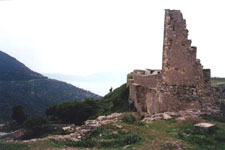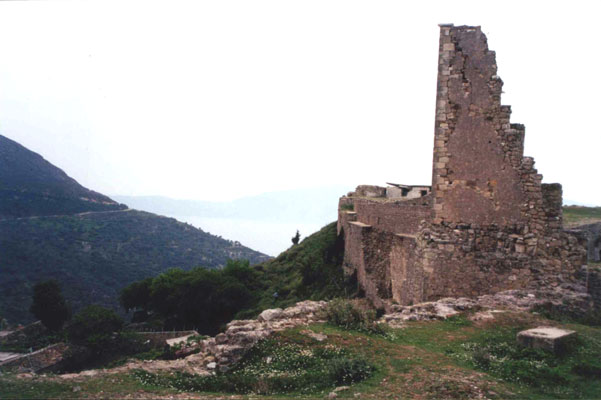| | Robert Elsie | AL Art | AL History | AL Language | AL Literature | AL Photography | Contact | |
Robert Elsie
Texts and Documents of Albanian History
BACK | AL History

Mountain fortress of Kanina near Vlora
(Photo: Robert Elsie).
1328, 1332, 1336
John Cantacuzene:
Unruly Nomads
Pay Homage to the Emperor
Typical of the many short references to the Albanians in Byzantine chronicles is the following text by the Emperor John VI Cantacuzene (r. 1347-1355), whose 'History' covers the years 1320-1356. Here as in other texts, the Albanian tribes are described as wild and unruly nomads living in mountainous regions in the summer months and migrating to the lowlands in the winter months.
While the emperor was spending about eight days in Achrida (Ohrid), the Albanian nomads living in the region of Deabolis (Devoll) appeared before him, as well as those from Koloneia (Kolonja) and those from the vicinity of Ohrid (1). They paid homage to the emperor and willingly offered him their services. Those who lived farther away on the borders of the Byzantine Empire were commanded by letters from the emperor to hasten to Thessalonika in order to pay homage, which they did a short time later.
While the emperor was staying in Thessaly (2), the unruly Albanians living in the Thessalian mountains appeared before him who, according to their tribal leaders, are called Malakasians, Buians and Mesarites and whose numbers reach 12,000. They paid homage to the emperor and promised to serve him, for they were afraid of being annihilated by the Byzantines at the onset of winter, living as they do, not in towns, but in the mountains and in inaccessible regions. Since they must abandon these regions in the winter due to the cold and snow, which falls in incredible amounts in such vicinities, they believed that they would easily fall prey to them.
A short time thereafter, it was reported by the governors of the western parts of the empire that the Albanians nomads from Balagrada (Berat) and Kanina (3), who are quick to rise to arms and are restless by nature, had violated the treaties with the emperor, attacking and pillaging the towns there in a savage manner. They had ventured to do the same thing earlier when a good number of the rabble banded together and pillaged the towns until the emperor despatched an army against them, forcing them to settle down and not to cause any further injustice to the inhabitants of the towns of the west. But when summer came, as soon as the emperor's army had been disbanded and the soldiers sent back home, they were no longer to be kept under control, and ravaged the towns there with their pillaging and open incursions. Now, many of them had banded together and wreaked great destruction upon Berat, Kanina, Kleisura (Këlcyra) and a fortress called Skreparion (Skrapar). After repeated attacks, they also took Timoros (Tomor), a fortress in the west of the country not far from Berat and entrenched themselves in it. For these reasons, the emperor resolved to lead a campaign against them (4). Since the Dux John (5), ruler of Acarnania, was already dead at this time, the emperor hurried to reach the west for he hoped to bring Acarnania under his control. During preparations, he thought it a good idea to bring in an auxiliary force of Turkish infantrymen from Ionia to put down the Albanians. Since the latter live in high and inaccessible mountain regions with numerous secret paths and hideouts, they cannot be overcome by horsemen, in particular since they take to the mountain peaks in the summer where, in view of the natural environment, even infantrymen have no easy task because the defendants can shoot at them from above. As such, he sent an emissary to Umur and requested an auxiliary force of infantrymen. Umur received the emperor's representatives with pleasure since he regarded it as an honour to do something for him, and sent the troops to Thessalonika right away. Soon thereafter, the emperor arrived there himself with his Byzantine forces, took the Turkish allies with him and marched through Thessaly against the Albanians. Ravaging their land, he advanced right through to Epidamnos (Durrës) and many Albanians were slain. When they received word of the advance of the emperor, assuming his army consisted of Byzantine cavalry alone, they took to the mountains and to their inaccessible regions, believing in this manner to have escaped annihilation. They were nonetheless attacked by light-armed Turkish forces and archers, who operate admirably in inaccessible regions, and were easily overcome, not only because they were unarmed, but also because they were thrown into a panic by the unexpected attack of the barbarians. Many Albanians were killed or taken prisoner. Those who managed to escape, left behind their wives, children and possessions, and took refuge in remote regions. The Turks enslaved their wives and children, although other members of their tribes, who maintained good relations with the emperor, managed to ransom some of them from the Turks. The emperor himself also allowed many of them to be ransomed when their relatives came to him and begged for their release. Indeed, he would have let even more of them, or indeed all of them, be ransomed, had their relatives approached him in time while the Turks were still under his command. Since, however, the petitioners came to him after the departure of the Turks, he could only ransom a portion of the prisoners. Most of them were sent to the east as slaves. The Byzantines themselves do not enslave people. They are not allowed to, unless they are barbarians who refuse to believe in the redemption of Christ, our Saviour. They did, however, take possession of countless herds of animals, not to mention much household equipment and other objects. It was even said, and the reports proved to be true after those affected by the disaster approached the emperor and gave him an account of their losses, that Byzantine forces had captured three hundred thousand head of cattle, five thousand horses and one million two hundred thousand head of sheep. The soldiers were of course not in a position to take that many animals back with them so they simply chased the owners away and left the animals to their own devices without shepherds. The inhabitants of the towns which had earlier been ravaged by the Albanians then came out and took possession of as many animals as they wanted without anyone stopping them. The former owners, too, once they had pledged submission and allegiance to the emperor, were allowed to take back many of the animals which they found wandering freely in the gorges and valleys. They also bought many animals back from the soldiers, who demanded one piece of gold for every five hundred head of sheep or one hundred head of cattle. Although among the troops it was formerly the custom to put aside one-fifth of the booty, be it great or small, as a tribute for the emperor, and an equal proportion for the Grand Steward (Domestikos), who was commander-in-chief of the whole army, hardly anyone bothered about this custom and no one forced the soldiers to put aside one-fifth of the gains. They were all allowed to take as much of the booty as they wanted, as if it flowed freely in immeasurable quantities.
Such were the outrages committed earlier by the Albanians against the inhabitants of the west and such was the punishment for their injustices. The towns which had formerly suffered from them benefited, to their great joy, doubly. On the one hand, they were freed from Albanian incursions and, on the other hand, they were able to take pleasure in the presence and provident care of the emperor. As such, they were all the happier and celebrated as never before. From the time of Emperor Manuel Comnenos (6) to that of Emperor Andronicus Palaeologus (7), no other Byzantine emperor had ever visited them and expressed his provident care for them to such an extent. While he was there, they therefore regarded the emperor as a supernatural being.
After the Albanians were defeated, the emperor sent home his Turkish allies, who proceeded through Thessaly and Bottiaea to Thessalonika and sailed from there back to Ionia.
(1) The meeting is estimate to have taken place about February 1328.
(2) Probably in the late autum of 1332.
(3) The fortress of Kanina is a few kilometres above Vlora on the southern Albanian coast.
(4) The expedition probably took place in the spring of 1336. cf. J. Cantacuzenus 1986, p. 232.
(5) Giovanni Orsini.
(6) Manuel I Comnenus (r. 1143-1180) visited Vlora in the summer of 1149.
(7) Andronicus III Palaeologus (r. 1328-1341).[Extract from: John Cantacuzenus: Geschichte, Stuttgart 1982, I, p. 190 = Book 1, 55, p. 279, lines 22sq.; II, p. 107 = Book II, 28, p. 474, lines 9-19; II, p. 120-123 = Book II, 32, p. 495-499. Translated by Robert Elsie. First published in R. Elsie: Early Albania, a Reader of Historical Texts, 11th - 17th Centuries, Wiesbaden 2003, p. 14-17.]
TOP
